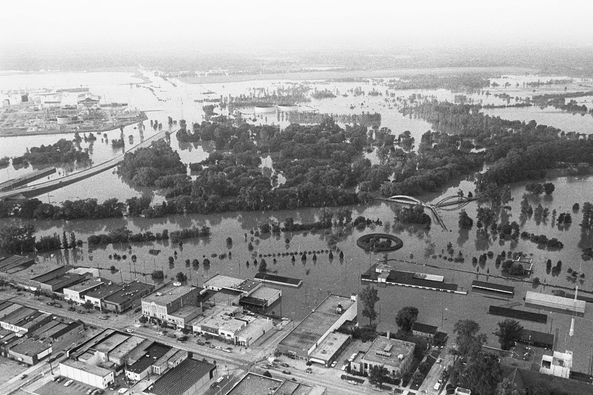The Great Michigan Flood of 1986 remains one of the most catastrophic natural disasters in the state’s history, reshaping landscapes, communities, and lives. Over several days in September 1986, a deluge of rain led to historic flooding across central and southeast Michigan, causing widespread destruction, evacuations, and a significant loss of property and infrastructure. This blog post delves into the causes, impact, and aftermath of this tragic event, highlighting the stories of resilience and recovery that emerged in its wake.
Featured Image: Midland County Emergency Management
Flood of 1986 in Michigan
The Prelude: Record Rainfall Sets the Stage

In early September 1986, Michigan was hit by an unusual weather pattern that set the stage for a catastrophic flood. Between September 10 and September 12, a slow-moving storm system brought unprecedented levels of rainfall to the state, particularly across central and southeastern regions. In just a few days, some areas received between 8 and 14 inches of rain—more than three months’ worth of precipitation in less than 72 hours.
The heaviest rainfall was concentrated in a region stretching from Midland to Saginaw and eastward toward the Thumb region, leading to a rapid and dramatic rise in river and stream levels. The storm caused record river crests along the Tittabawassee, Saginaw, Shiawassee, and Flint Rivers, overwhelming local flood defenses and inundating thousands of acres of land.
Unfolding Disaster: The Immediate Impact of the Great Flood of 1986

Widespread Flooding and Damage

The torrential rains caused rivers and streams to swell beyond their banks, flooding towns, homes, businesses, and farmlands. For example, the Tittabawassee River in Midland County reached its highest recorded level, devastating the city of Midland and surrounding areas. The city’s downtown was submerged, and entire neighborhoods were left underwater.
The floodwaters continued downstream, severely impacting cities like Saginaw and Bay City. By the time the rain ceased, an estimated 22,000 homes were flooded, and more than 10,000 residents were forced to evacuate. Infrastructure such as roads, bridges, and public utilities were heavily damaged or destroyed, paralyzing local communities and complicating rescue and relief efforts.
Human and Economic Toll
The human cost of the flood was significant, with at least ten people losing their lives due to the severe weather and flooding. Thousands of residents were displaced, seeking shelter in community centers, churches, and schools as their homes were submerged. The emotional toll on those who lost loved ones, homes, or livelihoods was immense.
Economically, the damage was catastrophic. The Great Michigan Flood of 1986 caused an estimated $500 million in damages at the time, equivalent to over $1 billion in today’s dollars. This included the destruction of homes and businesses and widespread damage to crops, which had devastating effects on the agricultural sector.
The Aftermath: A Community in Crisis

@BayCountyMI
Recovery Efforts and Community Response
In the immediate aftermath of the flood, local, state, and federal agencies, including the Federal Emergency Management Agency (FEMA), coordinated relief efforts to assist those affected. Emergency services worked around the clock to rescue stranded individuals, provide medical aid, and deliver food and water to those in need.
Community resilience was on full display as neighbors helped neighbors, and volunteers from across Michigan and neighboring states came to assist in the recovery efforts. Stories of heroism emerged, such as local residents using their boats to rescue stranded individuals and deliver supplies to cut-off communities. These acts of kindness and solidarity were a beacon of hope in a time of despair.
Federal Disaster Declaration
On September 12, 1986, President Ronald Reagan declared Michigan a federal disaster area, which opened the door for federal funding and resources to flow into the state. This declaration was critical in providing the necessary support to repair infrastructure, rebuild homes, and restore services in the flood-affected areas. Federal assistance included grants, loans, and financial aid to individuals and businesses, as well as funding to rebuild critical public infrastructure.
The Environmental Impact: A Changed Landscape

Alterations to Rivers and Ecosystems
The floodwaters did not just impact human communities; they also caused significant environmental changes. The intense flooding reshaped riverbanks, altered river courses, and damaged wetlands and forests. The Tittabawassee River, for example, saw significant alterations to its banks, and the floodplain was expanded in some areas due to erosion and sediment deposition.
Wetlands that served as natural flood buffers were heavily damaged, reducing their ability to mitigate future flooding. The sudden influx of freshwater into local lakes and rivers also disrupted aquatic ecosystems, affecting fish populations and other wildlife. In the aftermath, efforts were made to restore these natural habitats, but some changes proved irreversible.
Contamination and Pollution
The floodwaters also carried contaminants from industrial sites, farmlands, and sewage treatment plants, spreading them across the landscape. This led to concerns about long-term environmental impacts, particularly in areas near industrial centers and agricultural zones. The contamination of local water sources required extensive cleanup efforts, and some areas faced long-term issues with water quality.
Lessons Learned: Preparing for Future Floods

Improvements in Flood Management and Infrastructure
The Great Michigan Flood of 1986 served as a wake-up call for local and state governments regarding flood management and infrastructure resilience. In response to the disaster, investments were made to improve flood defenses, such as reinforcing levees, upgrading drainage systems, and constructing new flood barriers. Efforts were also made to enhance early warning systems and community preparedness, ensuring that residents receive timely alerts and have evacuation plans in place.
The Role of Climate Change
While an unusual weather pattern primarily caused the 1986 flood, it has also sparked discussions about the broader implications of climate change on extreme weather events. Scientists warn that Michigan and other parts of the Great Lakes region could face more frequent and severe flooding as the climate changes. This has prompted a renewed focus on sustainable urban planning, wetland restoration, and investment in climate-resilient infrastructure.
Remembering the Great Michigan Flood of 1986
Commemorating the Event
The Great Michigan Flood of 1986 is a turning point in the state’s flood preparedness and management approach. Memorials and events have been held to commemorate those who lost their lives and to honor the heroes who emerged in the crisis. Communities affected by the flood continue to share their stories, ensuring that future generations remember the lessons learned and the strength of the human spirit in the face of adversity.



